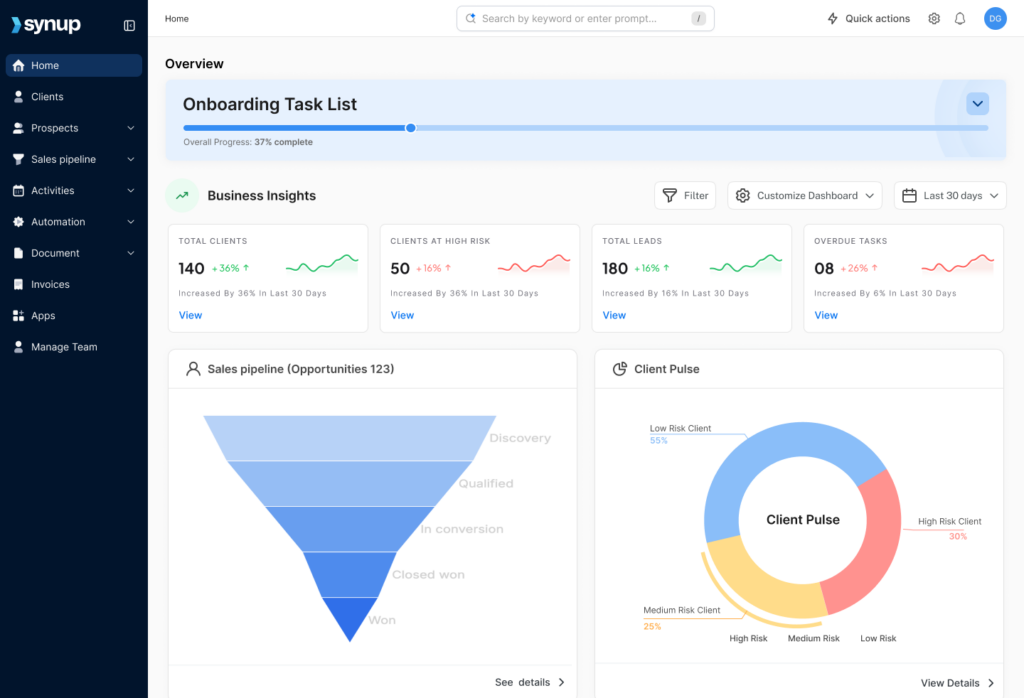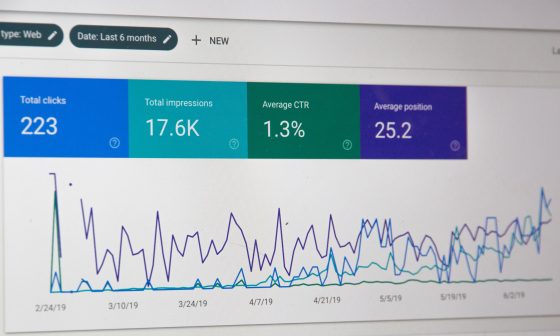Whether you’re a seasoned agency pro or just starting out, you’re bound to encounter the dreaded ‘challenging’ client.
But though it may be easier to believe otherwise, difficult clients aren’t always “bad” clients. More often than not, they’re confused, anxious about ROI, or simply not used to working with an agency. What looks like “bad behavior” is usually a symptom of misaligned expectations, unclear processes, or (most commonly) a lack of communication.
If you’re wondering how to deal with difficult clients, here’s the honest truth: it’s less about confrontation and more about structure.
At Synup, we’ve worked with over 600,000 businesses since 2014, everything from multi-location health providers to high-volume service brands. That means we’ve seen all client personalities and built systems to manage every one. Here’s what we’ve learned: most client issues can be fixed with better systems, not better tempers.
TL;DR: How to Deal with Difficult Clients
- Most “difficult” clients aren’t bad people. They’re confused, under pressure, or don’t know how agencies work. That’s on you to fix, not fight.
- Poor communication is usually the root problem. Vague scopes, unclear roles, or skipped onboarding often cause friction down the line.
- Spot trouble early. Red flags during sales calls include: unclear goals, asking for discounts constantly, or steamrolling the process.
- Set expectations from day one. Use onboarding checklists, an FAQ, and a clear explainer on how feedback, timelines, and reviews work. Train them how to work with you.
- Know your client types so you can manage them:
- Scope Crawlers keep adding “just one more thing”
- Micromanagers want daily updates and full control
- Ghosts disappear, then rush you for delivery
- Firefighters only show up when there’s a crisis
- Opinionators bring ten people into every decision
- Use dashboards and project tools to show progress. Notion, Trello, or ClickUp with read-only access works great. It stops the “any update?” emails.
- Always recap meetings in writing. People forget or misremember calls. Written summaries prevent “but I thought…” moments.
- Pre-mortems save projects. Before kickoff, ask what could go wrong and what success really looks like. This surfaces landmines early.
- Never reply emotionally. Pause. Draft. Reread. Your tone sets the tone. Calm responses earn more respect than reactive ones.
- Bring in a neutral third voice (like a senior or strategist) when conversations feel stuck or too tense. It resets the dynamic.
- Redirect vague feedback into actionable input. Ask what problem they’re trying to solve, not what they “don’t like.”
- Push back on scope creep. Anchor every request back to the original scope or KPIs. Don’t let “small changes” slide every week.
- Give clients limited visibility into your tools. Show them what’s relevant, but don’t let them run the show behind the scenes.
- Know when to walk away. If a client disrespects your team, blows up timelines, or ignores every boundary, let them go politely, but firmly.
Why Difficult Clients Aren’t the Enemy
It’s easy to label someone a “problematic client” when you’re knee-deep in revision rounds or frustratedly chasing feedback for the third time. However, the truth is that dealing with difficult clients often reflects misaligned expectations, which can be prevented or corrected.
Maybe you skipped the kickoff call over priorities. Maybe you said “yes” too much, too fast. Or maybe the client just didn’t understand how agency relationships are supposed to work. That’s not malice. That’s a gap you can fix.
Difficult clients aren’t trying to derail your day. They’re trying to protect their investment or are just not sure how this works, and it’s your job to guide them.
How To Spot a Difficult Client Before It’s Too Late
Most “difficult clients” don’t become that way overnight. You can usually spot the signs early, sometimes even on the discovery call.
Common Red Flags to Watch Out For:
- Vague goals but high pressure to “get it done”

Source: Reddit
- Frequent last-minute changes. Ever been stuck in a 2-month time loop?

Source: Reddit
- Undermining your advice with phrases like “our SEO person knows design”
- Asking for discounts during every conversation.

Source: Reddit
Does this “deal” sound familiar?
- Speaking over your team or ignoring your process

Source: Reddit
Pro Tip: Document everything from Day 1, even the Slack chats. If it’s not written down, it didn’t happen.
Different Types of Difficult Clients (and How to Handle Each)
Here’s how to navigate the different types of difficult clients:
1. The Scope Crawler
This client starts with a tight brief, then slips in “one more thing” every week.
Solution: Lock down your Scope of Work (SoW) with specific language. Include what’s in, what’s not, and how best to handle changes. No room for vagueness.
When they try to add new work midstream, use this line:
“Happy to explore that. Let’s map it out and send a revised estimate.”
It keeps things collaborative, but reminds them your time isn’t free.
2. The Micromanager
This one wants daily updates, pixel-perfect designs, and direct access to your developers.
Solution: Give them control without caving. Send weekly status reports, offer scheduled review slots, and keep communication tidy.
Use structured check-ins and not random WhatsApp messages. Tools like Notion or ClickUp work well here.
Bonus Tip: Show progress before they ask. If you don’t lead, they will, and it won’t be pretty.
3. The Ghost
They disappear for weeks, then come back demanding everything by this Friday, end of business day.
Solution: Build a simple communication rhythm from Day 1. Use templated status emails that include clear decision points.
Here’s a helpful format:
Subject: Project Update – Need Your Input by Friday
Body: Include progress summary, blockers, and required actions
Alternatively, build this into your contract. Be clear about how you handle unplanned delays.

Source: Reddit
You can also automate nudges via Slack bots or PM tools. Don’t chase manually every time; it’ll drain your team.
4. The Firefighter
Everything’s always urgent. They don’t respond until there’s a “crisis.”
You’ll hear things like: “I need this by tomorrow or we’ll lose the client!”
Solution: Don’t match their energy. Instead, create a clear escalation ladder and stick to it.
Say something like: “Let’s identify the real blocker here. We’ll propose a fix by EOD.”
Make ‘calm’ your superpower. You’ll stand out immediately.
5. The Opinionator (aka the Committee Client)
They crowdsource every decision to a dozen stakeholders. Suddenly, your clean design now has five logos and six fonts.
Feedback is vague, contradictory, or based on random personal taste.
Solution: Shift the conversation from opinion to evidence.
Say:
“We based this layout on user data showing higher conversions for single-column formats. Want to test it against a version with more content?”
Once you bring data into the room, the room quiets down.
If there’s a committee involved, designate one decision-maker. Non-negotiable.
10 Ways to Improve Communication With Difficult Clients
Dealing with difficult clients is part of agency life. Misunderstandings often spark when communication breaks down, and, again, in most cases, it’s not bad intent, but bad structure. Here’s how to deal with difficult clients and reduce friction, starting with clear, proactive communication:
1. Set Communication Protocols Early
Don’t wait for chaos to define how you talk. Set rules early.
Agree on one main platform for all communication, whether that’s email, Slack, or a client portal. If you’re confused, here’s the general consensus at Spiceworks, an IT company:
“I do think that apps like Slack and Teams etc have an advantage but only for short text messages; email is still better because you can really enter extensive text messages and explain the issue. I used apps to call the attention to an issue but email to explain it.” said Hans Hallebeek, an IT consultant in a SpiceWorks community discussion
Define how often updates go out. Set a default response time. This avoids 11pm Slack messages or conflicting updates sent across four platforms.
However, make sure to create an escalation path for emergencies.
2. Always Recap Calls in Writing
Have you ever left a Zoom call thinking everything’s aligned, only to receive an email asking something completely different? That’s why written recaps are essential.
After every strategy or status call, send an MoM that’s thorough and comprehensive.
Why this works: People forget things. Or they hear what they want to hear. Recaps serve as receipts and help avoid the classic “but I thought…” email later.
How to do it:
Create a recap template:
- Call summary
- Decisions made
- Next steps
- Timeline and Deadlines
- Responsible person(s)
Drop it into an email or Notion page within 2 hours of the call and follow up on what to do.
Pro Tip: Use a free template to draft your meeting notes. Some resources to check out include Canva and Zapier.
3. Don’t Just Tell: Show With Dashboards and Reports
Most difficult clients aren’t trying to be annoying. They only want to know what’s happening. Build dashboards that they can check anytime.
- Use tools like Notion, Trello, or ClickUp with read-only access.
- Visualize KPIs, timelines, and blockers.
- Update weekly with notes.
Why it matters: Clients often panic when they can’t see the work moving. A live board shows progress without them needing to ask.


4. Start with Pre-Mortems
Everyone does project retros (the post-mortem, so to speak), but few agencies do pre-mortems, where you and the client predict what might go wrong before anything starts.
Instead of only doing project reviews at the end, involve the client in a pre-mortem before you start.
Sit down during onboarding and ask:
- For approval of the project plan
- What would they like to add or remove from the outline or idea
- What’s tripped up past projects?
- What would frustrate you?
- What does “success” actually look like?
This helps you uncover landmines early. If they’re used to bad agency experiences, you get insight into their fears and expectations.
Importantly, make it a point to use simple language. Keeping up with the market, engaging with the right resources, and adopting new technology can help you present and speak like a top marketer, but this isn’t the best strategy for client communication.
Be clear, use native speech, and invite your clients to ask questions.
Pro tip: Let them talk. Don’t defend. Just document what they say and use it to build the project plan.
5. Don’t Reply Emotionally. Respond After a Pause
Yes, that passive-aggressive client email annoyed you. It might feel personal. Take a breath and don’t reply instantly. It almost never helps.
Walk away and take 30 minutes. Check the facts. Then respond from a calm, clear place.
It’s always a good idea to practice active listening. Don’t just wait for them to finish speaking. Actually hear them out.

Why this works: Your tone sets the tone. If you sound defensive or emotional, things can spiral. A short pause can defuse the situation.
Pro Tip: You may decide to draft responses in Google Docs and not Gmail when annoyed. That physical separation helps you reset before sending.
6. Bring in a Third Voice If Tensions Rise
Sometimes, you’re too close to the issue. If talks go in circles, ask a colleague or manager to join the next call.
- Introduce them as a fresh set of eyes.
- Let them mediate and reframe the discussion.
Sometimes, just having a senior team member or peer step into a meeting can shift the tone entirely.
It gives the client a fresh face and shows that the agency takes their concerns seriously. It also helps you feel less cornered.
Here’s a great way of looking at it:

Source: Reddit
7. Turn Subjective Feedback Into Solvable Problems
When a client says, “I just don’t like it,” you’re stuck. That feedback is vague, personal, and un-actionable.
So redirect with structure:
- Can you walk me through what problem this is trying to solve?
- What’s not resonating for your audience?
- Which user behavior are we trying to change here?
This shifts the conversation away from feelings and back to the business goals.
Bonus: Use a structured feedback form with fields like “What’s working,” “What’s not,” and “Why.”
8. Anchor Difficult Conversations in the Original Scope and KPIs
Don’t argue about taste. Go back to the original goals and deliverables. Create a Scope of Work (SoW) document. If the client asks for new work, treat it as a change request and not a freebie.
Scope creep starts with a “quick favor.” Stop it early by anchoring every new request to the original agreement. Here’s how to go about your SoW:
“I recommend in your scope of work to define three things: 1. What is included 2. What is extra 3. What you will not do. Most of the time we define 1 in detail, vagugely describe 2 and completely forget 3.”, said Darren Woolley, Global CEO & Founder at Trinityp3 in a forum discussion.
When a client asks for something new, remind them about what you agreed on. If this is outside, say you’re happy to scope it and price it out.
Pro move: Create a “Scope Tracker” in the client dashboard with original deliverables. That way, both sides stay aligned.
9. Give Clients Limited Access to Your PM Tools
Most clients feel left out because they can’t see what’s happening. To reduce update emails without giving away your internal chaos, share a client-facing version of your PM tool.
- In Trello: Use one board with sanitized cards
- In Notion: Share a timeline view of deliverables
- In ClickUp: Add them as a guest with view-only rights
It creates transparency without giving them control. Clients feel informed, but not in your workspace.
Reminder: Don’t overload the board. Keep it high-level and clean.
10. Know When to Fire a Client (Last Resort)
Not every relationship can be saved. If a client refuses to respect your team, burns out your staff, or ignores every boundary, you can walk away.
Here’s a simple way to say it:
“This project no longer aligns with how we deliver our best work. We’ll support a handover this week.”
It’s respectful and not reactive. It gives both sides closure without blame.
Agency life tip: One fired client can free up space for three better ones.
How to Set Better Expectations Before Issues Start
Setting expectations early is foundational. You can avoid most tension by showing clients how to work with you from day one. That means formalizing what’s often left unsaid.
Start with an onboarding checklist or deck. Keep it clear and client-friendly. Include:
- Your communication channels and response times
- What feedback cycles look like
- Turnaround timelines for design, dev, or strategy
- What’s in scope and how changes get handled
You’re not just explaining your process. You’re training your client on how the partnership works. Remember:
“Clients who are learning are great for agencies who are also learning.”

Without clarity upfront, small assumptions snowball into confusion. When a client expects a one-day turnaround and you deliver in five, it feels like failure even if you’re following your usual process.
Pro tip: Include an FAQ sheet that covers things like delays, asset submissions, or feedback etiquette. Clients love knowing the rules upfront.
Growing a Community Into a Lead Engine
Some of the best clients don’t come through cold leads; they grow inside communities you build.
When you invest in a branded space where potential clients learn from you, see your value, and connect with others, the sales conversation becomes easier. That reduces misalignment before the project even starts.
Start small: Create a free Slack or Circle group focused on your niche. Populate it with value. Examples include:
- Lead magnets pinned in a welcome channel
- Weekly AMA sessions hosted by your team
- Monthly themes (e.g., Local SEO, Lead Gen Funnels, Visual Identity Tips)
- Light CTAs like “Book a call” or “See our portfolio” in your pinned messages
Assign a community manager: This can be a part-time team member who checks in, welcomes new members, and sparks conversation.
For instance: As a boutique web dev agency, you could start hosting monthly “Launch Review Nights” where early-stage founders could share their landing pages. You may offer gentle, expert feedback live on Zoom. Within four months, you could start converting attendees into long-term clients before ever pitching.
A community lets prospects self-qualify. They see how you think. They experience your values and culture. When they become clients, you skip the messy onboarding curve. That’s half the battle in dealing with difficult clients.
Agency Tools That Reduce Client Friction
You don’t need a bloated tech stack. But you do need the right tools used the right way. Clear visibility and streamlined updates help clients feel in control without needing daily calls.
Try Synup OS for client communication
Many agencies now use Synup OS to power:
- A live portal that shows project status and tasks
- Automated weekly updates sent to client inboxes
- One central space for assets, notes, and brand data

It reduces update chases, email clutter, and “where’s that file again?” headaches. You can start with Synup by booking a demo now.
Other client-favorite tools
- Loom for video replies: Use screen shares to explain complex feedback or walk clients through next steps. You can also do this with Google Videos for free.
- Fathom or tl;dv: Record and summarize calls. Let clients replay moments instead of asking twice. (Note: A recent Google update now lets Gemini record and transcribe & make notes of your meetings, for free)
- Trello, Notion, or Google Sheets: Use shared boards or trackers for timelines, assets, and deliverables. Simplicity works; just stay consistent.
When clients feel blind, they get anxious. Anxious clients ask for updates, question the scope, or micromanage. But when they see your process clearly, they back off and trust more. That makes how to handle irate clients a conversation you rarely need to have.
Final Thoughts: Strong Communication Makes Difficult Clients Manageable
You can’t avoid every tough client. But you can avoid letting them derail your work. When you build a strong onboarding process, create a visible client workflow, and support your communication with the right tools, you create clarity. That clarity builds trust.
And when trust is strong, even difficult clients calm down, collaborate, and follow your lead.
How to Handle Difficult Agency Clients: FAQs
What are the signs of a difficult client during onboarding?
Look for vague goals, last-minute changes, constant haggling, or resistance to process. These are early red flags. Ask deeper questions and set tighter boundaries before starting. Pay attention to how they speak about previous agencies or consultants. If they’ve “fired four agencies in two years,” you’re likely walking into a storm.
How do I set boundaries without sounding rude?
Use clear, kind language like: “To stay on schedule, we stick to two rounds of revisions. We’re happy to add more at a scoped cost.” Respect is mutual. Boundaries help protect your team from burnout, especially on long retainer projects. If a client expects daily updates or instant replies, agree on comms cadence in writing.
How do I know when to fire a client?
If a client continuously ignores timelines, disrespects your team, pushes scope without approval, or creates a toxic work environment, it’s time to walk away. It’s unsalvageable. A good test: If your team starts dreading meetings or avoiding updates, it’s not just “a hard week.” That’s a cultural drain.


